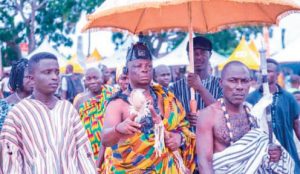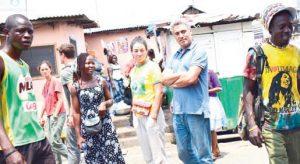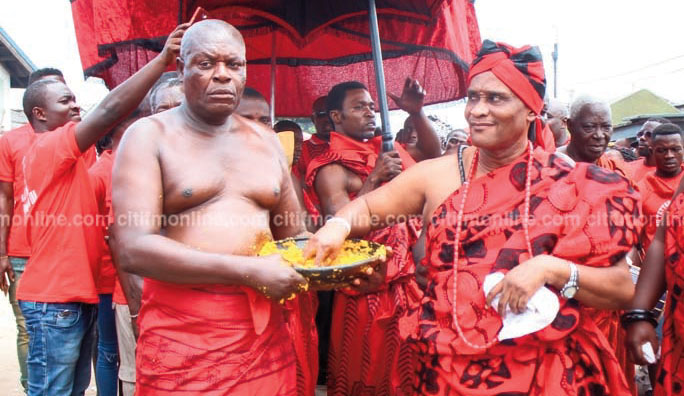Festivals have increasingly become a significant tool for both tourism and the re-imaging and re-branding of cities and regions as modern cultural centres around the world, and Ghana is no exception.
If you are a tourist in Ghana, then you can’t miss the chance to attend some of Ghana’s important festivals so that you can experience festivals and celebrations in this multi-cultural country.
Today, NEWS-ONE brings to you some of the best festivals in August and September. This is part of an initiative by the office of the Ministry of Tourism Arts & Culture to guide tourists to the best destinations in Ghana.
If you are visiting Ghana any moment, you’ll definitely want to consider taking part in these festivals.

Homowo
This harvest festival is celebrated by the Ga people from the Greater Accra Region of Ghana.
It begins with the sowing of millet by the traditional priests in May. After this, a 30-day ban on drumming is imposed on the land by the priests.
The festival is highlighted at varying times by different quarters of the Ga tribe. The Ga Mashie group of the tribe will celebrate theirs a little earlier than the La group.
Homowo recounts the migration of the Gas and reveals their agricultural success in their new settlement. According to Ga oral tradition, a severe famine broke out among the people during their migration to present day Accra. They were inspired by the famine to embark on massive food production exercises which eventually yielded them bumper harvest.
Their hunger ended and with great joy they ‘hooted at hunger’; this is the meaning of the word ‘homowo’.
The celebration usually takes place in August, rarely in July or September. It is characterised by activities such as the sprinkling of ‘kpokpoi’ (the festival dish) to the gods and ancestors for spiritual protection, procession of twins through the principal streets, traditional drumming and dancing and general merry-making. A month before the celebration, there is a ban on noise-making.

Kundum
Kundum Festival is celebrated by the coastal tribes of the Western Region of Ghana. The four month-long festival is celebrated at weekly intervals from town to town between August and November every year. The main highlights of the festival are the stool cleansing, the ancestral prayers and the drumming and dancing that accompanies Ghanaian festivals. It is celebrated by both the Ahantas and the Nzema people of the Western Region and has a lot of legend behind it. One school of thought has it that the Kundum Festival originated from a tree in a village called Aboade whose fruits ripen only once a year. Thus, the people adopted the ripening of the fruit to start the celebration. Another legend has it that a hunter from the village was on a hunting expedition and he saw dwarfs dancing to the rhythm of a strange music. He studied them for months, learnt the dance and came home to teach his people. Thus, the origin of the Kundum Festival and the Kundum dance. The way it is celebrated varies from town to town. Every one of them makes an effort to add some uniqueness to their own celebration to make it grand. Kundum is one of the few festivals in Ghana that has evolved with the modern trend of life. Aside the usual dancing and feasting to which it is associated, the Kundum Festival is also a time for the people of the town and their chiefs to sit down. There is conflict resolution, planning of developmental projects for the town and welcoming home of natives who have travelled. This is to instill sound moral values into the people. Each day of the week has a unique celebration. The natives prepare for the festivals by getting new cloths and footwear made from beautiful material to show off what they have. The celebration starts on a Sunday with the beating of drums on the outskirts of the town at five different places. The significance of this is to seek the guidance of the gods in the celebration.
Akwambo Festival
Akwambo is observed annually mainly in the Agona and Gomoa Districts in the Central Region of Ghana. The festival commemorates the journey and arrival of the founding settlers of the four towns of Gyinankoma, Ekrawfo, Atakwaa and Otabenadze.
Celebrations are held at various times of the year, usually lasting for several days and can include different activities, according to local custom.
However, most Akwambo Festivals share certain common customs such as the ritual path clearing, a public gathering known as a durbar and family or community reunions. There may also be music and dance performances, soccer games and parades. In some areas, young people hold an all-night party. A durbar is usually held near the end of the Akwambo Festival. Community leaders and chiefs are carried on covered litters in a procession of drummers, dancers, singers, musicians and soldiers. A public reception follows, during which speeches are made by politicians and other dignitaries. Also at this time, community members may bring forward any concerns or problems needing the leaders’ attention. The festival, which literally means ‘path-clearing’, is usually celebrated in August.
Asafotufiami Festival
The Asafotufiami is a festival celebrated by the people of Ada Traditional Area in the Dangme East District. It is a rich cultural heritage celebrated annually in the first week of August.
The festival is a remembrance of the achievements in the wars for settlement fought by our ancestors, hence the name ‘Asafotufiami’. ‘Asafotu’, as the name implies, is a company of warriors who fire their muskets in celebration. These days, the festival is a grand homecoming for the Ada diaspora. The celebration starts on Thursday in the first week of August and goes on until the following week. Young men are initiated and instructed in the ancient tactics of warfare, the paramount chief of Ada and the chiefs of the various clans gather for processions and speeches and parties and celebrations continue throughout the whole festival. On Sunday, there is an open air church service and the following days are filled with beach parties, boat races, river excursions and football matches.
Fetu Afahye
Fetu Afahye is celebrated by the Oguaa people of Cape Coast. It is celebrated annually every September and is noted for its colourful nature and the celebration atmosphere it generates. There is a great history behind the celebration of the Fetu Afahye. It is said that during the days of their ancestors, there was an outbreak of a disease among the people which killed a lot of people. They prayed to their gods, and as history has it, the gods helped the people to eradicate the disease. Thus, the name ‘Fetu, which in the local dialect means ‘Efin Tu’ (dirt cleansing). One can, therefore, say that the festival is about keeping the town clean and preventing a repeat of the epidemic that befell their ancestors. Before the actual celebration, the paramount chief of the Ogua Traditional Area (Omanhene) goes into confinement for a week. This is to enable him to meditate with the gods and seek guidance for the people. He also takes care of his health by seeking medical attention to ensure that he is fit for the celebration. Fetu Afahye begins on the last Monday in August. On this day, a vigil is kept during the night at the Fosu lagoon. All the citizens of the town come out to witness a procession of the priest and priestesses of the town till day break. This is amidst drumming and singing of traditional songs as the priests and priestesses make their evocations for the coming year.


